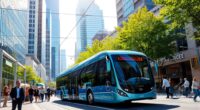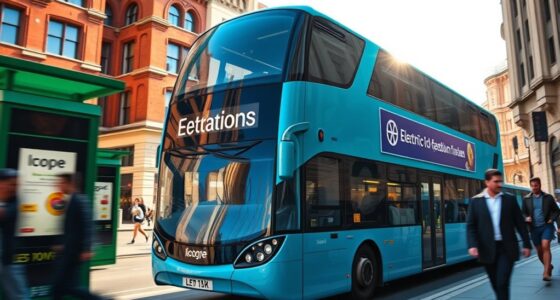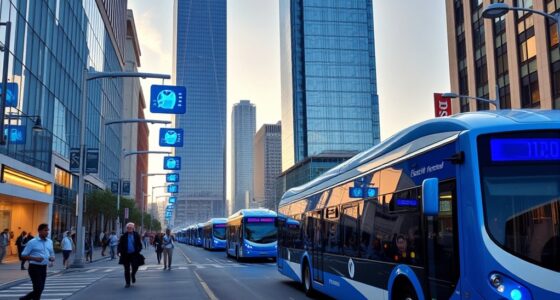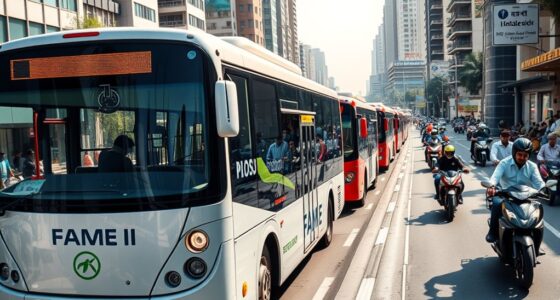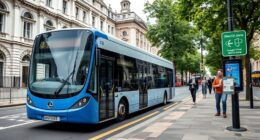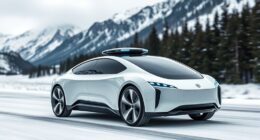Implementing electric buses in rural areas is more practical than you might think. They handle long, diverse routes reliably, even in snowy or rugged terrains. Most sites already have enough power to support charging, with minimal upgrades needed. Operating costs are competitive over time, and maintenance is lower. Community partnerships and renewable energy integration boost sustainability. If you want to see how these successful deployments overcome challenges and prove durable, keep exploring the details.
Key Takeaways
- Electric buses in rural Washington and Colorado demonstrate route adaptability, handling diverse terrains and weather conditions reliably.
- Existing infrastructure often suffices, with minimal upgrades needed for charging stations, thanks to thorough utility assessments.
- Cost comparisons show electric buses are financially competitive long-term, with stable electricity prices and lower maintenance costs.
- Electric buses reliably meet daily mileage needs, supported by overnight charging and proven battery durability in cold climates.
- Successful implementation relies on strong community partnerships with utilities and stakeholders, integrating renewable energy and local support.

Implementing electric buses in rural areas offers a promising solution to reduce emissions and improve community health, but it comes with unique challenges. You may worry about whether electric buses can handle the long, variable routes typical of rural communities. Fortunately, tests in rural Washington show these buses can adapt to diverse routes, including long distances between schools.
Similarly, in Colorado’s West Grand School District, buses reliably operated through snowy weather and rugged terrain, demonstrating resilience under tough conditions. Concerns about charging infrastructure might also arise, but findings suggest most rural sites already have sufficient power capacity, reducing the need for costly upgrades. For example, in Knox County, initial fears about limited charging capacity proved unfounded, thanks to existing infrastructure.
Still, planning for future growth is wise; many regions, like Maine, initially doubted EV suitability but saw success after testing, proving their viability.
To support electric bus adoption, innovative infrastructure solutions are key. Many schools are installing rapid DC chargers on-site, utilizing existing parking and power supplies. Western Power’s assessments confirm that most rural school sites require minimal electrical upgrades, making installation more feasible.
Partnerships with utilities help design phased infrastructure plans, ensuring cost-effective scaling. Some communities are considering shared charging hubs at community centers or recreation facilities, which can serve as backup stations when needed. These investments align with regional growth in EV demand, ensuring the network remains future-proof and scalable.
From an economic perspective, electric buses are becoming more feasible. A study in Washington found that electric and diesel contracts reached cost parity over 17 years, showing electric buses can be financially competitive. Electricity prices tend to be stable, reducing financial risks associated with volatile fuel markets.
Maine secured federal grants to cover initial purchase costs, easing the upfront financial burden. Over time, electric buses also save money through lower maintenance costs, as they’ve fewer moving parts and require less servicing. Rural regions, like Washington, have demonstrated that scaling electric bus fleets across multiple towns can be economically attainable without relying on subsidies.
Operationally, electric buses perform well in rural settings. They reliably cover routes up to 80 miles daily, even in cold temperatures like those in Maine. Overnight charging usually provides enough power for daily routes, and driver training minimizes disruptions during the transition.
Battery reliability remains strong, with no significant failures reported in extreme conditions. These buses help communities meet environmental goals by cutting CO2 emissions, reducing noise pollution, and improving air quality—benefits that directly impact children’s health. Additionally, integrating battery technology into planning ensures ongoing improvements and durability.
Furthermore, pairing charging stations with solar energy plans in Washington highlights the potential for renewable integration, further lowering carbon footprints.
Engagement from local stakeholders has been essential. Maine’s non-profit, A Climate to Thrive, co-managed the rollout, fostering community support and collaboration. Utility companies, like Evergy in Knox County, have played key roles in designing and implementing the infrastructure.
These partnerships ensure that electric bus projects are tailored to local needs, sustainable, and successful in overcoming the unique challenges of rural environments.
Frequently Asked Questions
What Are the Long-Term Maintenance Costs for Electric Buses?
You’re curious about long-term maintenance costs for electric buses. Over their lifespan, they tend to be more cost-effective than diesel buses because of lower maintenance needs, fewer parts, and extended component lifespan.
While battery replacements can be significant, they’re needed only about once every decade. With advancements in technology and predictive maintenance, you can expect ongoing costs to stay relatively low.
Making electric buses a smart, economical choice long-term.
How Do Electric Buses Perform in Extreme Weather Conditions?
You might wonder how electric buses handle extreme weather. In snow and cold, they perform better than diesel buses thanks to balanced weight distribution, which improves traction and safety.
However, cold temperatures can reduce their range by around 33% and strain batteries, making heating and starting more challenging.
Despite these issues, successful deployments in places like Minnesota and Canada show that with proper planning, electric buses can operate reliably in harsh winter conditions.
What Funding Opportunities Are Available for Rural Electric Bus Projects?
You might be surprised to learn that federal investments aim to fund billions in rural electric bus projects, making transportation greener and more accessible.
You can access EPA grants, which offer $500 million annually without requiring matching funds, and FTA grants for bus replacements.
State and local incentives, utility partnerships, private loans, and leasing options further support your efforts, helping overcome infrastructure challenges and reduce upfront costs for rural areas.
How Is Passenger Safety Ensured During Electric Bus Operation?
You guarantee passenger safety by regularly maintaining the electric bus’s systems, including batteries and brakes, to prevent failures.
You also implement rigorous driver training on handling icy conditions and emergency protocols.
Additionally, you monitor real-time diagnostics for early issue detection and use route planning tools to avoid hazardous areas.
Backup charging stations and safety procedures for thermal management further protect passengers, ensuring a safe and reliable ride every time.
What Are the Training Requirements for Drivers and Maintenance Staff?
Think of training as the backbone of safe electric bus operation. You need to guarantee drivers learn high-voltage safety, route optimization, and emergency procedures.
Maintenance staff must master diagnostics, battery management, and repair protocols, especially for high-voltage systems.
Tiered certification programs and virtual reality simulations help reduce travel and training costs.
Staying current with proprietary software and safety standards is essential to keep your team prepared and your fleet running smoothly.
Conclusion
So, you’ve successfully rolled out electric buses in rural areas—what a groundbreaking achievement! Who knew that replacing noisy, polluting vehicles with silent, eco-friendly ones would somehow boost the local economy and save the planet? Hopefully, this inspires others to follow your trailblazing path. After all, saving the environment is just a few electric buses away—because nothing says progress like charging your vehicles overnight and calling it a day.

